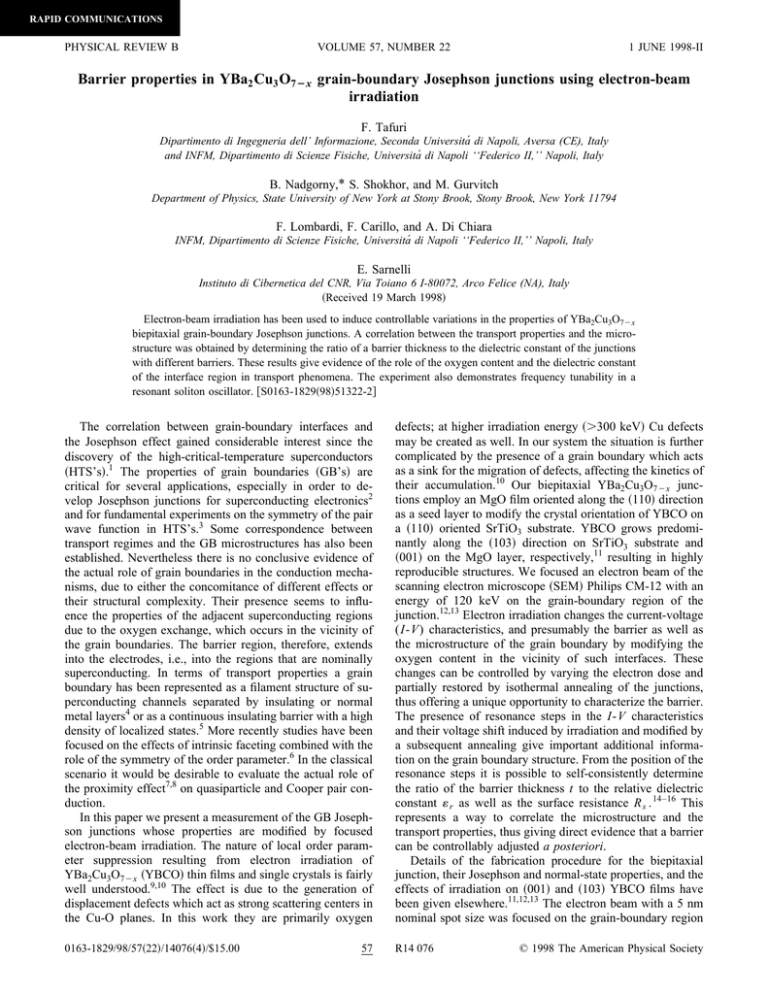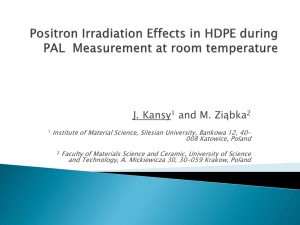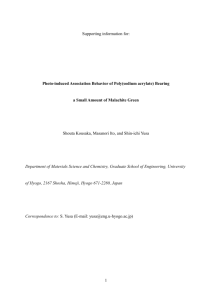Barrier properties in YBa Cu O grain-boundary Josephson junctions using electron-beam
advertisement

RAPID COMMUNICATIONS PHYSICAL REVIEW B VOLUME 57, NUMBER 22 1 JUNE 1998-II Barrier properties in YBa2 Cu3 O72x grain-boundary Josephson junctions using electron-beam irradiation F. Tafuri Dipartimento di Ingegneria dell’ Informazione, Seconda Universitá di Napoli, Aversa (CE), Italy and INFM, Dipartimento di Scienze Fisiche, Universitá di Napoli ‘‘Federico II,’’ Napoli, Italy B. Nadgorny,* S. Shokhor, and M. Gurvitch Department of Physics, State University of New York at Stony Brook, Stony Brook, New York 11794 F. Lombardi, F. Carillo, and A. Di Chiara INFM, Dipartimento di Scienze Fisiche, Universitá di Napoli ‘‘Federico II,’’ Napoli, Italy E. Sarnelli Instituto di Cibernetica del CNR, Via Toiano 6 I-80072, Arco Felice (NA), Italy ~Received 19 March 1998! Electron-beam irradiation has been used to induce controllable variations in the properties of YBa2Cu3O72x biepitaxial grain-boundary Josephson junctions. A correlation between the transport properties and the microstructure was obtained by determining the ratio of a barrier thickness to the dielectric constant of the junctions with different barriers. These results give evidence of the role of the oxygen content and the dielectric constant of the interface region in transport phenomena. The experiment also demonstrates frequency tunability in a resonant soliton oscillator. @S0163-1829~98!51322-2# The correlation between grain-boundary interfaces and the Josephson effect gained considerable interest since the discovery of the high-critical-temperature superconductors ~HTS’s!.1 The properties of grain boundaries ~GB’s! are critical for several applications, especially in order to develop Josephson junctions for superconducting electronics2 and for fundamental experiments on the symmetry of the pair wave function in HTS’s.3 Some correspondence between transport regimes and the GB microstructures has also been established. Nevertheless there is no conclusive evidence of the actual role of grain boundaries in the conduction mechanisms, due to either the concomitance of different effects or their structural complexity. Their presence seems to influence the properties of the adjacent superconducting regions due to the oxygen exchange, which occurs in the vicinity of the grain boundaries. The barrier region, therefore, extends into the electrodes, i.e., into the regions that are nominally superconducting. In terms of transport properties a grain boundary has been represented as a filament structure of superconducting channels separated by insulating or normal metal layers4 or as a continuous insulating barrier with a high density of localized states.5 More recently studies have been focused on the effects of intrinsic faceting combined with the role of the symmetry of the order parameter.6 In the classical scenario it would be desirable to evaluate the actual role of the proximity effect7,8 on quasiparticle and Cooper pair conduction. In this paper we present a measurement of the GB Josephson junctions whose properties are modified by focused electron-beam irradiation. The nature of local order parameter suppression resulting from electron irradiation of YBa2Cu3O72x ~YBCO! thin films and single crystals is fairly well understood.9,10 The effect is due to the generation of displacement defects which act as strong scattering centers in the Cu-O planes. In this work they are primarily oxygen 0163-1829/98/57~22!/14076~4!/$15.00 57 defects; at higher irradiation energy ~.300 keV! Cu defects may be created as well. In our system the situation is further complicated by the presence of a grain boundary which acts as a sink for the migration of defects, affecting the kinetics of their accumulation.10 Our biepitaxial YBa2Cu3O72x junctions employ an MgO film oriented along the ~110! direction as a seed layer to modify the crystal orientation of YBCO on a ~110! oriented SrTiO3 substrate. YBCO grows predominantly along the ~103! direction on SrTiO3 substrate and ~001! on the MgO layer, respectively,11 resulting in highly reproducible structures. We focused an electron beam of the scanning electron microscope ~SEM! Philips CM-12 with an energy of 120 keV on the grain-boundary region of the junction.12,13 Electron irradiation changes the current-voltage (I-V) characteristics, and presumably the barrier as well as the microstructure of the grain boundary by modifying the oxygen content in the vicinity of such interfaces. These changes can be controlled by varying the electron dose and partially restored by isothermal annealing of the junctions, thus offering a unique opportunity to characterize the barrier. The presence of resonance steps in the I-V characteristics and their voltage shift induced by irradiation and modified by a subsequent annealing give important additional information on the grain boundary structure. From the position of the resonance steps it is possible to self-consistently determine the ratio of the barrier thickness t to the relative dielectric constant « r as well as the surface resistance R s . 14–16 This represents a way to correlate the microstructure and the transport properties, thus giving direct evidence that a barrier can be controllably adjusted a posteriori. Details of the fabrication procedure for the biepitaxial junction, their Josephson and normal-state properties, and the effects of irradiation on ~001! and ~103! YBCO films have been given elsewhere.11,12,13 The electron beam with a 5 nm nominal spot size was focused on the grain-boundary region R14 076 © 1998 The American Physical Society RAPID COMMUNICATIONS 57 BARRIER PROPERTIES IN YBa2 Cu3 O72x GRAIN- . . . R14 077 FIG. 1. ~a! Typical I vs V curves of the junction biep No. 36 before irradiation are shown as a function of temperature. In the inset the curve at T510 K, obtained by subtracting the ‘‘ohmic’’ current V/R N from the total current I, is compared with the expected Lorentzian. From this fit we estimated Q S,N 50.8 and R S 5140 mV. ~b! Typical I vs V curves of the junction biep No. 36 after irradiation are shown as a function of temperature. In the inset, using the same procedure as in ~a! for the data at T58.5 K, we obtained Q S,N 50.27 and R S 5240 mV. and scanned once all the way across the microbridge ~along the grain boundary! with a linear fluence of 1.531016 e/cm.12,14 In order to study the time variation of junction parameters, the samples were measured after a series of isothermal annealings in the He atmosphere of the cryostat. The typical I-V curves of the biepitaxial junctions before irradiation are shown at different temperatures in Fig. 1~a!. At voltages on the order of 1024 V steps can be clearly identified. These resonance steps have been frequently observed before in HTS GB Josephson junctions15,16 and associated with the propagation of the electromagnetic waves in a junction that acts as a long parallel plate resonator ~Fiske modes!. The ac Josephson effect can cause self-induced resonance when f n 5nc/2L52eV n /h, where n is the order of the resonance at a frequency f n and L is the junction length. The Swihart velocity is given by c5c 0 (t/« r d) 1/2, where c 0 is the free space speed of light and d5t12l L , respectively. The London penetration depth l L at T50 K has been taken 140 nm in agreement with the experimental observations.15 Subtracting the ‘‘ohmic’’ current V/R N ~R N is the normal-state resistance! from the total current I, a typical resonance profile is obtained @inset of Fig. 1~a!#. By fitting this curve with the expected Lorentzian, an estimate of the total loss Q in the system can be extracted. Q consists mainly of losses from the quasiparticle conductance (;1/Q qp), the surface resistance (;1/Q S,N ) and radiation (;1/Q rad); the latter has practically no contribution in our geometry, so 1/Q exp 51/Q qp11/Q S,N . Since Q qp can be evaluated, we can estimate Q S,N and hence the surface resistance R S,N 5 p m 0 (t 12l L )/Q S,N . For the data at T510 K we estimated for the first-order resistance Q S,N 50.8 and R S 5140 mV. Figure 1~b! shows the I-V curves of the same junction at different temperatures after irradiation. In this case the critical current decreases approximately by a factor of 8 at T59 K, while the maximum working temperature of the junction T c decreases approximately from 73 to 45 K. We also observed a signifi- RAPID COMMUNICATIONS R14 078 F. TAFURI et al. 57 FIG. 2. I vs V curves, measured at T58 K, before irradiation ~open triangles!, after irradiation ~full triangles!, after the first ~12 min at 330 °C! ~full squares! and the second ~24 h at room temperature! ~open circles! annealings, respectively. In the inset ~a! the ‘‘ohmic’’ current V/R N is subtracted from the total current. In the inset ~b! the dependence of the principal junction parameters, normalized to the values before irradiation, is shown as a function of the annealing time t. The values before irradiation ~T54.2 K! are I C 544 mA, T C 573 K, R N 520 V, t/« r 50.18 Å, and R S 5140 mV, respectively. cant increase of R N from 20 to 65 V. More importantly, irradiation induces a shift in the position of the first Fiske resonance from 240 to 150 mV. This corresponds to a decrease of the Swihart velocity from 2.43106 to 1.53106 m/sec and the t/« r value from 0.18 to 0.07 Å, respectively. l L has been assumed weakly dependent on irradiation and aging effects according to experimental evidence.15,17 Using the same procedure as in Fig. 1~a! for the data at T58.5 K in the inset of Fig. 1~b! we obtained Q S,N 50.27 and R S 5240 mV. Hence the surface resistance noticeably increases after irradiation. The original properties of the junctions can be partly restored by annealing, as shown in Fig. 2. In the inset ~a! of Fig. 2 the resonance profiles and their voltage shifts are presented. Annealing tends to shift the position of the Fiske steps to higher voltages, thus increasing the ratio of t/« r . In the inset ~b! the dependence of the principal junction parameters, normalized to the values before irradiation, is plotted as a function of the annealing time. All the parameters have been measured at T54.2 K. I C , T C , and t/« r increased in the course of annealing, while R S and R N decreased, with the most rapid change observed in the first hour of annealing. The simultaneous change of the junction parameters as well as their dependence on the annealing time suggests that the effects due to the electron irradiation, being linked to the junction configuration, can reveal basic information on the grain-boundary microstructure. Within a framework of a simple tunnelling theory, a transmission coefficient T exponentially depends on the barrier thickness t, and on the wave vector within the barrier. An increase of t and the barrier height would explain a dramatic decrease of I C and increase of R N . The experimental evidence, that the changes of I C and R N induced by irradiation and their dependencies on the annealing time are different, suggests that Cooper pairs and quasiparticle conduction processes are governed by different effective barriers. This situation can occur, for instance, in a defect-assisted tunnelling.7,5 On the other hand, the decrease of the t/« r ratio after irradiation would indicate that the dielectric constant « r increases faster than the barrier thickness. This effect could be explained by assuming a certain type of barrier, that depends on the dielectric constant, such as a semiconductorlike barrier.7 Consequently, both I C and R N would be linked to « r . Additional evidence of the possibility of this type of a barrier is given by the same experiment on a similar junction where an irradiation dose of 231021 e/cm2 was used. In this case an electron beam was scanned within a rectangular region containing the grain boundary, about 1 mm in width. The junction resistance R before and after irradiation is shown in Fig. 3 as a function of temperature T. The resistance R after irradiation increases at temperatures below 50 K as in semiconducting contacts. R after irradiation at T54.2 K is 103 times higher than the normal-state resistance of the Josephson junction before irradiation. The Josephson current observed before irradiation @inset ~a! of Fig. 3# was completely suppressed. However, after a 6 month annealing at room temperature the junction exhibited metalliclike behavior of R in the entire temperature range from 300 to 4.2 K. For temperatures lower than 10 K, the nonlinear behavior in I vs V characteristics at low voltages, visible in the inset ~b! Fig. 3, is associated with the reappearance of the Josephson current. These results can also be explained by assuming a barrier with semiconductorlike properties. A uniform irradiation enhances the oxygen exchange between the barrier and the adjacent regions, providing more favorable conditions to observe the carrier deficiency close to the grain-boundary region due to disordered or deficient oxygen. Oxygen exchange induced by irradiation would, therefore, modify both the barrier structure, affecting its dielectric constant and transparency, and the superconducting regions close to the interface. The fact that the original properties of the GB junction do not completely recover allows us to speculate that the defects migrate to the grain boundary and get trapped in the adjacent region. Finally the observed dependence of the t/« r ratio on irradiation and annealing time has important implications for the fundamental issues of the Josephson effect, providing the tunability of the phase velocity for the electromagnetic wave and vortex propagation in the YBCO GB junctions. In particular our experiment shows that it is possible to tune the frequency of a resonant soliton oscillator, which is usually fixed once the structure is fabricated. Moreover, it can be RAPID COMMUNICATIONS 57 BARRIER PROPERTIES IN YBa2 Cu3 O72x GRAIN- . . . R14 079 FIG. 3. Resistance R of junction biep No. 37 is shown as a function of temperature T before irradiation ~open squares! and after high dose irradiation ~full circles!. In the inset ~a! the I vs V characteristic before irradiation is reported at T54.2 K, exhibiting a typical Josephson behavior. In the inset ~b ! I vs V characteristics of biep No. 37 after a 6 month annealing at room temperature are shown as a function of T. The junction exhibited metalliclike behavior of R in the entire temperature range from 300 to 4.2 K. done locally and even only within a selected part of the barrier, thus providing a versatile tool to introduce inhomogeneities and to modify the boundary conditions for soliton propagation.14 In summary, we have demonstrated that electron-beam irradiation induces a shift in the position of the Fiske steps and changes the ratio of the barrier thickness to the relative dielectric constant. After a uniform ‘‘blanket’’ irradiation the junction resistance increases at lower temperatures. Although the possibility of a d-wave nature of the HTS electrodes may influence some aspects of our interpretation, we argue from *Present address: Naval Research Laboratory, Washington, D.C. 20375. 1 P. Chaudari, J. Mannhart, D. Dimos, C. C. Tsuei, C. C. Chi, M. M. Oprysko, and M. Scheuermann, Phys. Rev. Lett. 60, 1653 ~1988!; 61, 219 ~1988!. 2 I. Braginski, in New Superconducting Electronics, edited by H. Weinstock and R. Walstson ~Kluver Academic, Dordrecht, 1993!, p. 89; S. Shokhor, B. Nadgorny, M. Gurvitch, V. Semenov, Yu. Polyakov, K. K. Likharev, S. H. Hou, and J. M. Phillips, Appl. Phys. Lett. 67, 2869 ~1995!. 3 C. C. Tsuei, J. R. Kirtley, C. C. Chi, L. S. Yu-Jahnes, A. Gupta, T. Shaw, J. Z. Sun, and M. B. Ketchen, Phys. Rev. Lett. 73, 593 ~1994!; J. R. Kirtley et al. Nature ~London! 373, 225 ~1995!; P. Chaudary and S.-Y. Lin, Phys. Rev. Lett. 72, 1084 ~1994!. 4 B. H. Moeckly, D. K. Lathorp, and R. A. Buhrman, Phys. Rev. B 47, 400 ~1993!. 5 R. Gross and B. Mayer, Physica C 180, 235 ~1991!. 6 J. Mannhart, H. Hilgenkamp, B. Mayer, Ch. Gerber, J. R. Kirtley, K. A. Moler, and M. Sigrist, Phys. Rev. Lett. 77, 2782 ~1996!, and references therein. 7 E. L. Wolf, Principles of Electron Tunneling Spectroscopy ~Clarendon, New York, 1985!. 8 M. Yu. Kupryanov and V. F. Luckichev, Zh. Eksp. Teor. Fiz. 94, 139 ~1988! @Sov. Phys. JETP 67, 1163 ~1988!#; F. Tafuri, Phys. Rev. B 56, 91 ~1997!, and references therein. the consistency of our results that we have given evidence of modification of the barrier and the grain-boundary microstructure. This is likely to be due to the change in the oxygen content in the vicinity of the junction and the dielectric constant of the grain boundary. The authors would like to thank Professor Antonio Barone for valuable comments. This work was partially supported by the project PRA-INFM ‘‘HTS Devices.’’ Many thanks to Maria Chiara for her help during the preparation of this paper. 9 J. Giapinzakis, D. M. Ginsberg, M. A. Kirk, and S. Ockers, Phys. Rev. B 50, 15 967 ~1994!; A. Legris, F. Rullier-Albenque, E. Radeva, and P. Lejay, J. Phys. I 3, 1605 ~1993!; E. M. Jackson, B. D. Weaver, G. P. Summers, P. Shapiro, and E. A. Burke, Phys. Rev. Lett. 74, 3033 ~1995!. 10 S. Tolpygo, J.-Y. Lin, M. Gurvitch, S. Y. Hou, and J. M. Phillips, Phys. Rev. B 53, 12 462 ~1996!. 11 A. Di Chiara, F. Lombardi, F. Miletto Granozio, U. Scotti di Uccio, F. Tafuri, and M. Valentino, IEEE Trans. Appl. Supercond. 7, 3327 ~1997!. 12 F. Tafuri, S. Shokhor, B. Nadgorny, M. Gurvitch, F. Lombardi, and A. Di Chiara, Appl. Phys. Lett. 71, 125 ~1997!. 13 S. K. Tolpygo, S. Shokhor, B. Nadgorny, A. Bourdillon, J. Y. Lin, S. H. Hou, J. M. Phillips, and M. Gurvitch, Appl. Phys. Lett. 63, 1696 ~1993!. 14 A. Barone and G. Paternó, Physics and Applications of the Josephson Effect ~Wiley, New York, 1982!. 15 D. Winkler, Y. M. Zhang, P. A. Nilsson, E. A. Stepanstov, and T. Claeson, Phys. Rev. Lett. 72, 1260 ~1994!. 16 J. Mannhart, R. Gross, K. Hipler, R. P. Huebner, C. C. Tsuei, D. Dimos, and P. Chaudari, Science 245, 839 ~1989!. 17 S. K. Tolpygo, S. Shokhor, B. Nadgorny, J. Y. Lin, S. H. Hou, J. M. Phillips, and M. Gurvitch, IEEE Trans. Appl. Supercond. 5, 2521 ~1995!; A. Hoffmann, I. Schuller, A. Gilabert, M. G. Medici, F. Schmidl, and P. Seidel, Appl. Phys. Lett. 70, 2461 ~1997!.



